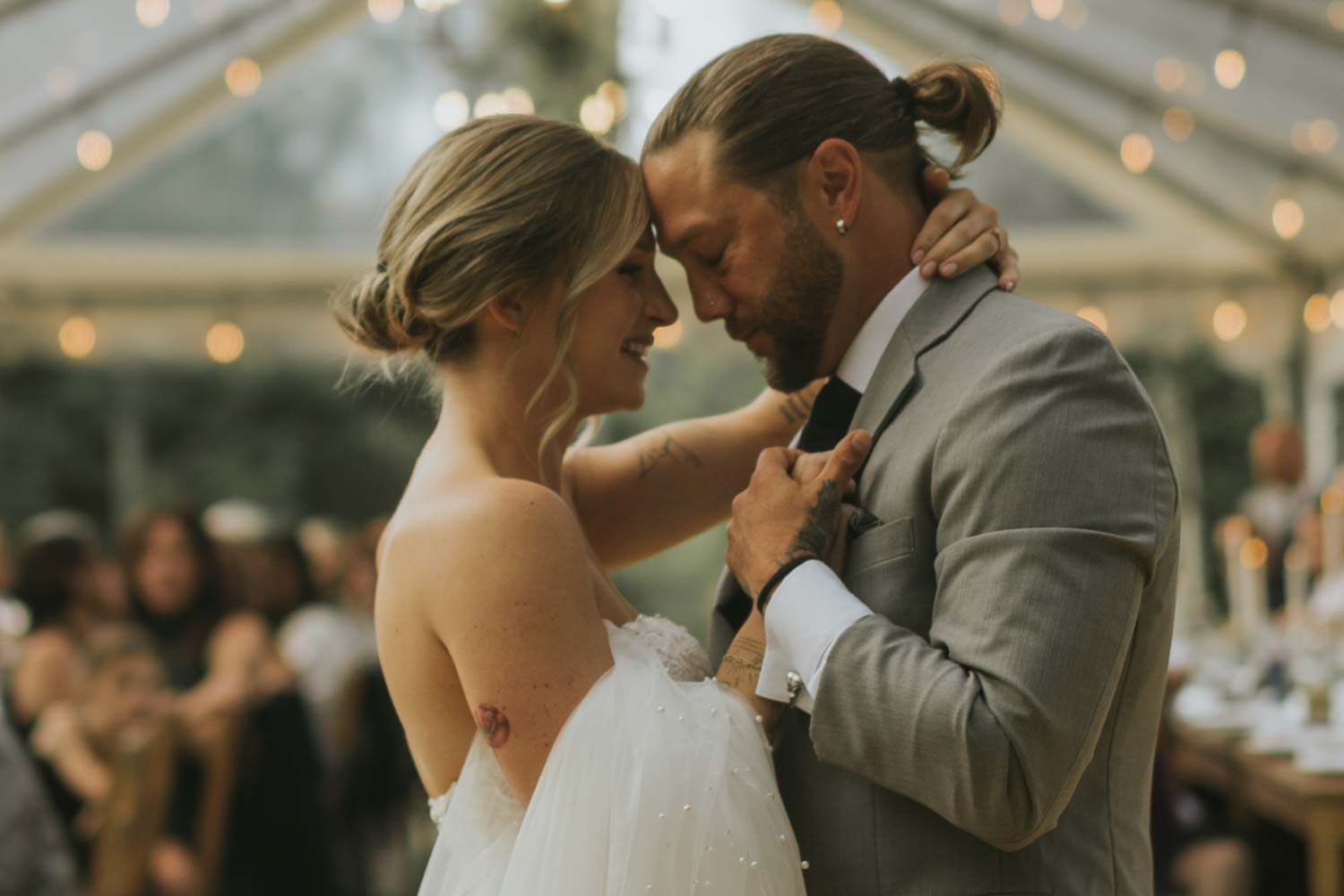Planning a wedding can seem like an overwhelming task, with so many decisions to make and details to take care of. One of the most important elements in planning a successful wedding is creating a timeline that outlines when each event should start and end. Having a well-thought-out timeline will help ensure your special day runs smoothly and you don’t miss out on any important moments or activities. Here are some tips for creating your perfect wedding day timeline!

1. Create a master list of all the events you want to include in your timeline
Creating a master list of all the events to include in your wedding day timeline is essential to ensure that you don't miss out on any important moments or activities. It's best to start by writing down everything you’d like to include, from the big ones such as the ceremony and reception, to the smaller details like cake-cutting.
There are a variety of online resources available with templates, examples, and tips to help you create the perfect wedding day timeline. Websites such as The Knot, Wedding Wire, and Brides have comprehensive wedding planning guides that include step-by-step instructions for creating a master list of events for your timeline.
There are a variety of online resources available with templates, examples, and tips to help you create the perfect wedding day timeline. Websites such as The Knot, Wedding Wire, and Brides have comprehensive wedding planning guides that include step-by-step instructions for creating a master list of events for your timeline.

2. Decide on when each event should take place
Once you have your master list of events for your wedding timeline, it's time to decide when each event should take place. This requires careful consideration of both logistics and personal preferences. For instance, if you’re having a religious ceremony and reception, you may want to consider the timing based on religious observances or cultural traditions. If you’re having a destination wedding, you may want to factor in time for traveling and sightseeing.
It's also important to plan based on personal preferences. If you or someone else attending the wedding has dietary restrictions, make sure there is enough time allotted between events to accommodate that. Another consideration could be organizing smaller events such as bridal showers or rehearsal dinners on different days if you are having a multi-day event.
It's also important to plan based on personal preferences. If you or someone else attending the wedding has dietary restrictions, make sure there is enough time allotted between events to accommodate that. Another consideration could be organizing smaller events such as bridal showers or rehearsal dinners on different days if you are having a multi-day event.

3. Break down the day into sections and decide how long each section will last
Breaking down the day into sections and deciding how long each section will last is essential for creating a successful wedding timeline. In order to ensure that each event is given enough time, it’s important to estimate the amount of time each activity needs. For example, consider the amount of time needed for hair and makeup, the ceremony and any special rituals or activities that may be included such as unity sand ceremonies or flower petal tossing.
When planning out the reception portion of your timeline, you should factor in meal service and any special dances or performances such as a first dance or bouquet toss. If there are speeches or toasts planned, make sure they are allotted enough time while still leaving room for other activities. You may also want to include some extra time in case an event runs over so that all your guests can enjoy everything without feeling rushed.
Whenever possible, try to assign an exact start and end time for each event so everyone knows when it’s scheduled for. Additionally, give yourself some “cushion” time in between events just in case something takes longer than expected or you want to steal away with your new spouse before the reception starts! With careful planning and consideration, creating a perfect wedding day timeline can be stress-free and enjoyable.
When planning out the reception portion of your timeline, you should factor in meal service and any special dances or performances such as a first dance or bouquet toss. If there are speeches or toasts planned, make sure they are allotted enough time while still leaving room for other activities. You may also want to include some extra time in case an event runs over so that all your guests can enjoy everything without feeling rushed.
Whenever possible, try to assign an exact start and end time for each event so everyone knows when it’s scheduled for. Additionally, give yourself some “cushion” time in between events just in case something takes longer than expected or you want to steal away with your new spouse before the reception starts! With careful planning and consideration, creating a perfect wedding day timeline can be stress-free and enjoyable.

4. Plan for time between events, such as travel or photo sessions
It's important to factor in time for travel and photo sessions between events. After deciding when each event should take place, you'll want to plan for time between events such as travel or photo sessions. This is especially important if you're having a destination wedding, as you may need more time to get from one location to another. It's also important if you have hired a professional photographer - make sure there is enough time allotted for them to capture all the special moments throughout the day.

5. Add buffer times for unexpected delays or changes in plans
Adding buffer times for unexpected delays or changes in plans is an essential part of creating your perfect wedding day timeline. Unexpected issues can arise during any event, and it’s important to be prepared by having extra time built into the timeline. This will allow you to quickly adjust should something unexpected arise, without compromising the timeline or delaying other events.
When creating a wedding day timeline, it's important to factor in buffer times for emergencies such as inclement weather, traffic delays, vendors running late, or last minute guests needing to be accommodated. Additionally, having extra time can allow for more flexibility in case there are requests from family members or friends that weren’t accounted for when initially planning the timeline.
It's best to add at least 15-30 minutes between each event. This will give you enough time to handle any unforeseen issues without throwing off the entire schedule. You may also want to add additional buffer times throughout the course of the day so you can make adjustments if needed without feeling rushed or overwhelmed.
Finally, you should also make sure that everyone involved with your special day is aware of the buffer times in case something arises and needs to be addressed quickly. This can help ensure that everyone knows what they need to do if an issue arises and how long they have to address it before moving on with the next event. Having these safeguards in place will help ensure everything runs smoothly on your big day!
When creating a wedding day timeline, it's important to factor in buffer times for emergencies such as inclement weather, traffic delays, vendors running late, or last minute guests needing to be accommodated. Additionally, having extra time can allow for more flexibility in case there are requests from family members or friends that weren’t accounted for when initially planning the timeline.
It's best to add at least 15-30 minutes between each event. This will give you enough time to handle any unforeseen issues without throwing off the entire schedule. You may also want to add additional buffer times throughout the course of the day so you can make adjustments if needed without feeling rushed or overwhelmed.
Finally, you should also make sure that everyone involved with your special day is aware of the buffer times in case something arises and needs to be addressed quickly. This can help ensure that everyone knows what they need to do if an issue arises and how long they have to address it before moving on with the next event. Having these safeguards in place will help ensure everything runs smoothly on your big day!

6. Make sure that everyone involved knows their roles and responsibilities ahead of time
Creating a perfect wedding day timeline is essential for ensuring that everything runs smoothly on your special day. But it’s not just about the timing of events - you also need to make sure that everyone involved knows their roles and responsibilities ahead of time in order to ensure that everything goes according to plan. By properly communicating expectations and assigning tasks, you can help ensure that all components run like clockwork on your big day. Here are some tips for making sure everyone knows their roles and responsibilities before the big event.
• Utilize a wedding planner or coordinator who can keep everyone on track.
• Set up meetings with vendors, family members and bridal party members in advance to outline their roles and responsibilities during the ceremony and reception.
• Keep in touch with the bridal party throughout the planning process to ensure that everyone knows what’s expected of them.
• Communicate any changes in plans or unexpected issues to all involved parties as soon as possible.
Following these tips will help ensure that all components run smoothly on your special day! With careful planning and communication, you can create a timeline that works for your wedding without having to stress about it on your big day.
• Utilize a wedding planner or coordinator who can keep everyone on track.
• Set up meetings with vendors, family members and bridal party members in advance to outline their roles and responsibilities during the ceremony and reception.
• Keep in touch with the bridal party throughout the planning process to ensure that everyone knows what’s expected of them.
• Communicate any changes in plans or unexpected issues to all involved parties as soon as possible.
Following these tips will help ensure that all components run smoothly on your special day! With careful planning and communication, you can create a timeline that works for your wedding without having to stress about it on your big day.

7. Finalize your timeline with an estimated start and end time for each event
Once you have created your timeline and added buffer times for unexpected delays or changes, the next step is to finalize it with an estimated start and end time for each event. Doing this will help to ensure that everything runs smoothly on your special day by giving everyone involved a clear schedule to work off of.
When estimating start and end times, be sure to consider how long each event typically lasts and factor in any extra time needed for unexpected delays or changes. Additionally, you should keep in mind factors such as:
• The number of people attending an event
• The size of the venue
• The distance between venues
• Any additional activities that need to be done
It’s also important to make sure that all the vendors are aware of their start and end times so that they can plan accordingly. This includes caterers, photographers, DJs, florists and any other vendors who may need to coordinate with one another throughout the day. By communicating these timelines ahead of time, you can ensure that all vendors are on the same page when it comes to timing and expectations.
Finally, it’s essential to communicate these timelines with anyone else involved in the wedding party such as family members, bridal party members and guests. Make sure everyone knows exactly when events are happening and how long they should last so that there are no surprises on your wedding day! With accurate start and end times set for each event, you can rest assured knowing that everything will run smoothly on your special day!
When estimating start and end times, be sure to consider how long each event typically lasts and factor in any extra time needed for unexpected delays or changes. Additionally, you should keep in mind factors such as:
• The number of people attending an event
• The size of the venue
• The distance between venues
• Any additional activities that need to be done
It’s also important to make sure that all the vendors are aware of their start and end times so that they can plan accordingly. This includes caterers, photographers, DJs, florists and any other vendors who may need to coordinate with one another throughout the day. By communicating these timelines ahead of time, you can ensure that all vendors are on the same page when it comes to timing and expectations.
Finally, it’s essential to communicate these timelines with anyone else involved in the wedding party such as family members, bridal party members and guests. Make sure everyone knows exactly when events are happening and how long they should last so that there are no surprises on your wedding day! With accurate start and end times set for each event, you can rest assured knowing that everything will run smoothly on your special day!

8. Have a backup plan ready in case something goes wrong during the day
No matter how much time and effort you put into planning your perfect wedding day, there’s always the possibility that something could go wrong. That’s why it’s important to have a backup plan ready in case of any unexpected issues or mishaps. By having a contingency plan in place, you can rest assured knowing that even if something goes awry on your big day, you will be prepared and able to handle it with grace and ease. Here are some tips for creating an effective backup plan for your special day.
A sample contingency plan for your wedding day would be to have an emergency bag ready. This should include items such as band-aids, painkillers, sewing kit, extra jewelry pieces, phone chargers, extra copies of all important documents, snacks and water. Having this bag on hand will help you to be prepared for any unexpected issue that arises on your wedding day.
In addition to making sure you have a backup plan in place, it is also important to communicate any changes or issues with your vendors and bridal party members ahead of time so that everyone is aware of the situation. For example, if there are inclement weather conditions on the day of the wedding, be sure to let your wedding venue know so they can make any necessary preparations in advance. Additionally, if there are delays during the wedding photos or reception due to family members arriving late or unforeseen circumstances arising throughout the day, it’s important to let everyone involved know right away so they can adjust their plans accordingly.
Finally, it’s essential to have a designated person who can act as a point of contact in case something goes wrong during the day. This could be a friend or family member who is familiar with all aspects of the wedding and can help troubleshoot any issues that arise quickly and efficiently. By having someone who is knowledgeable about all aspects of the wedding in charge of handling last minute problems or changes in plans, you can rest assured knowing that everything will be taken care of if something unexpected happens.
With careful planning and attention to detail, creating your perfect wedding day timeline does not have to be a stressful experience. By taking the time to consider factors like the number of guests, size of venue, distance between venues, and any additional activities that need to be done, you can ensure that everything runs smoothly on your special day. Additionally, it is important to communicate all start and end times with vendors and other involved parties so that everyone is aware of their expectations. Finally, make sure you are prepared in case something goes wrong by having a designated point of contact as well as an emergency bag with all necessary items ready for any last minute changes or issues. With these tips in mind, you will be able to create your perfect wedding day timeline with ease!
A sample contingency plan for your wedding day would be to have an emergency bag ready. This should include items such as band-aids, painkillers, sewing kit, extra jewelry pieces, phone chargers, extra copies of all important documents, snacks and water. Having this bag on hand will help you to be prepared for any unexpected issue that arises on your wedding day.
In addition to making sure you have a backup plan in place, it is also important to communicate any changes or issues with your vendors and bridal party members ahead of time so that everyone is aware of the situation. For example, if there are inclement weather conditions on the day of the wedding, be sure to let your wedding venue know so they can make any necessary preparations in advance. Additionally, if there are delays during the wedding photos or reception due to family members arriving late or unforeseen circumstances arising throughout the day, it’s important to let everyone involved know right away so they can adjust their plans accordingly.
Finally, it’s essential to have a designated person who can act as a point of contact in case something goes wrong during the day. This could be a friend or family member who is familiar with all aspects of the wedding and can help troubleshoot any issues that arise quickly and efficiently. By having someone who is knowledgeable about all aspects of the wedding in charge of handling last minute problems or changes in plans, you can rest assured knowing that everything will be taken care of if something unexpected happens.
With careful planning and attention to detail, creating your perfect wedding day timeline does not have to be a stressful experience. By taking the time to consider factors like the number of guests, size of venue, distance between venues, and any additional activities that need to be done, you can ensure that everything runs smoothly on your special day. Additionally, it is important to communicate all start and end times with vendors and other involved parties so that everyone is aware of their expectations. Finally, make sure you are prepared in case something goes wrong by having a designated point of contact as well as an emergency bag with all necessary items ready for any last minute changes or issues. With these tips in mind, you will be able to create your perfect wedding day timeline with ease!








